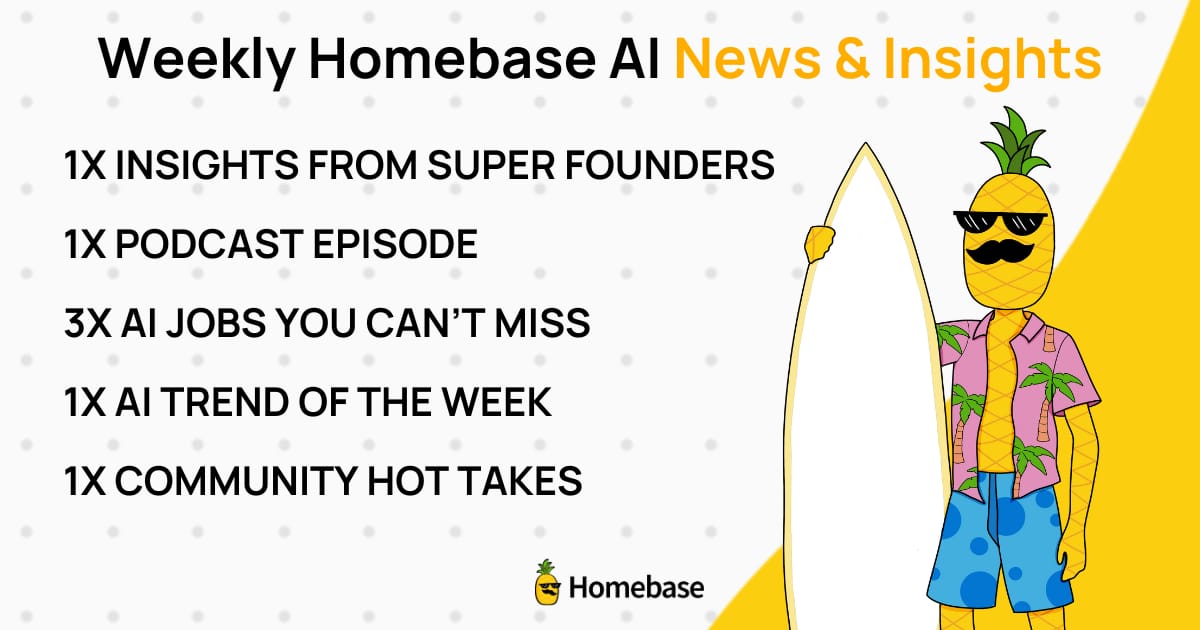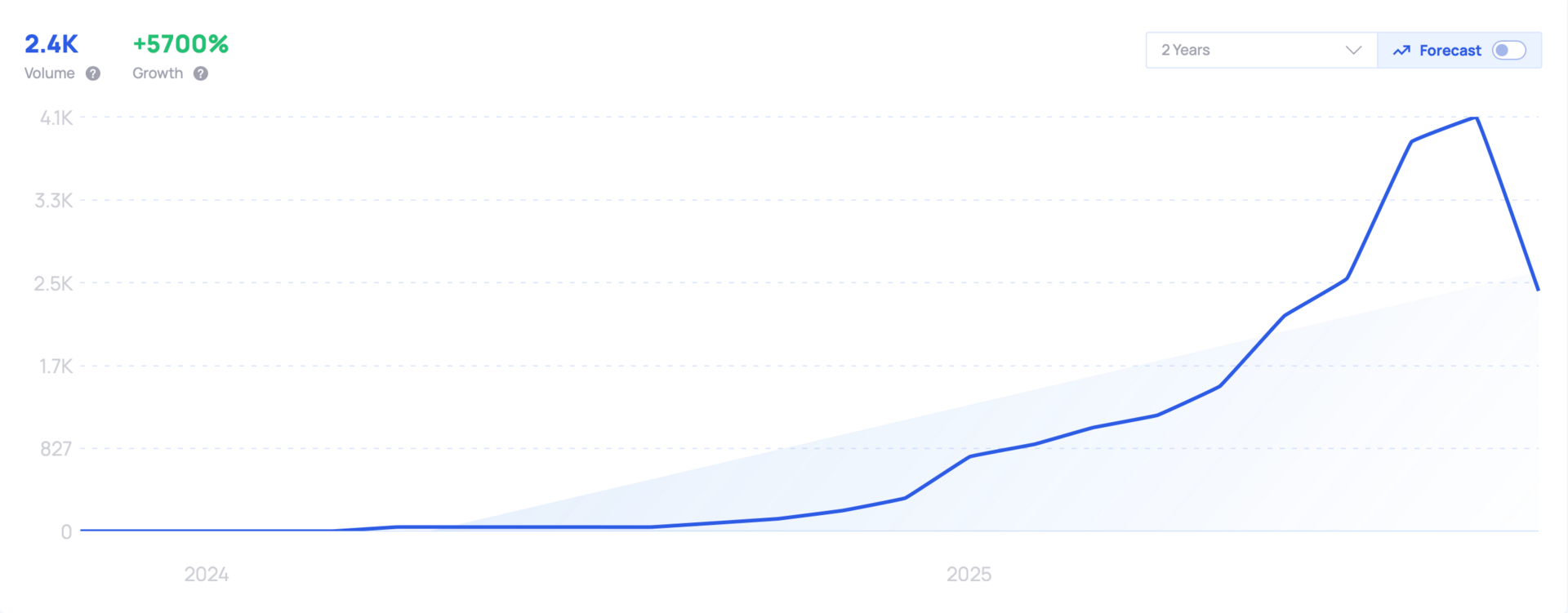- The Homebase
- Posts
- State-of-the-art AI localization for apps in CI/CD
State-of-the-art AI localization for apps in CI/CD
Ship multilingual features faster, release more often, and have more paying customers. Lingo.dev brings AI localization into your CI/CD so all locales launch together, on-brand, and without refactors.

Welcome to Homebase AI - A weekly newsletter where we share our interviews with founders & leaders building next-gen AI companies and curate interesting news, insights & trends in the AI space for our community members.
What’s on tap today:
Podcast
Our interview with Max Prilutskiy
3 AI Jobs You Can’t Miss
What's trending in AI this week
Community Update
How Homebase Helps You
AI FOUNDER STORY
From “translations block release” to “ship all locales today”
Quick Background
Max Prilutskiy is the co-founder and CEO of Lingo.dev, an AI localization engine built by and for developers and a YC Fall ’24 alum who started coding at nine, led engineering at Typeform, then shipped and exited Notionlytics.
Lingo.dev turns localization into a developer-native workflow, engine, CLI/CI, SDK, and a build-time compiler. So teams ship on-brand translations across 42+ languages without blocking delivery.
In early 2025, the company announced a multi-million seed to scale the engine and open-source footprint while staying laser-focused on DX and translation quality.
The bottleneck Max refused to accept
Max kept seeing the same failure mode: features were ready, translations weren’t.
Hackathon interviews echoed the pain, week-long delays and five-to-six-figure bills just to launch globally.
A thin GPT wrapper won Best DevTool, but the insight was bigger: the issue wasn’t “translation”, it was the process blocking developers. So the solution had to live in CI and the build.
Turning i18n from refactor to config
Lingo.dev’s engine composes LLMs for brand-voice, product-aware translations.
The CLI/CI fingerprints diffs and opens automated PRs on every push.
The JavaScript SDK handles real-time content.
The unlock: the Compiler analyzes React at build via AST, extracts+injects translations, and makes apps multilingual with zero t-functions, zero key files, zero refactor.
Net effect: months of foundational i18n disappear, and ~1 week per feature returns to the roadmap.
Key Achievements & Insights:
The Problem Today →
Developers shuttle files to agencies, wait days to weeks, and redeploy for every update, exactly when features are ready.
The Breakthrough →
Put translations where engineering lives: compose LLMs for context and voice, wire CI for automated PRs, and cover 42+ languages so global roadmaps stop stalling.
The Proof Story →
Teams report saving ~1 week per feature; the Compiler collapses months of i18n refactor into a single build step that scales with component count.
The Big Example →
A large React app turns multilingual post-build by enabling the Compiler in Next.js or Vite, no invasive rewrites.
Why It Matters (vision line)
Product velocity compounds, developer focus returns to shipping, and global revenue unlocks faster, with enterprise readiness (e.g., SOC 2) and a growing open-source community accelerating adoption.
Watch the full interview below! 👇
The Ultimate Lesson
Team, taste, traction
Max closed the round in 10 business days by driving a single, exponential traction chart and a team hired for judgment over keystrokes.
Work harder than you think possible
He optimizes like an athlete, deep focus sprints, strict routines, and a no-news diet—because compounding output beats performative busyness.
Curious Hook Driven Call To Action — Read the full interview →
“It works at build time and the moment the app finishes building, it’s already multilingual… No refactoring, no rewriting is needed.”
JOIN THE AI REVOLUTION
AI JOBS YOU CAN’T MISS!
💼 Senior Fullstack Engineer, Growth & Monetization @ LangChain
📍San Francisco, CA | 💰 Competitive
LangChain powers reliable AI agents at scale with open-source (LangChain, LangGraph) and LangSmith for evaluation, observability, and deployment.
They’re hiring a growth-focused full-stack engineer to build 0 to 1 systems that drive acquisition, activation, and self-serve monetization.
You’ll:
Ship full-stack features across React/TypeScript, Python/Go owning onboarding to monetization and time-to-value improvements.
Build experimentation infrastructure, usage metering, upgrade triggers, and pricing/packaging flows.
Partner with Product, Design, GTM, and Analytics to run data-driven experiments that boost retention and expansion.
Ideal for: Builders with deep React/TS + Go/Python, Postgres/Redis, and growth/monetization experience; PLG/dev-tools and LLM/GenAI familiarity is a plus.
💼 EPD Business Operations Lead (IPS) @ Scale AI
📍Doha, Qatar | 💰 Competitive
Scale AI’s International Public Sector team uses AI to tackle high-impact government problems building custom apps, generating training data, and upskilling teams worldwide.
They’re hiring a business ops lead to design and run the systems that power hyper-growth in the region turning vision into execution across product, engineering, and delivery.
You’ll:
Orchestrate cross-functional planning and execution; own project/staffing pipelines, reporting, and program cadences.
Build the internal tooling + knowledge base (deep Notion) and streamline procurement/budgeting, contracts, and rev-rec with Finance/Legal.
Create scalable processes that speed product development and data delivery; enable and upskill teams to operate with clarity and velocity.
Ideal for: 5+ yrs in product/strategy/biz ops at high-growth tech or top consulting; systems thinker with strong analytics, Notion/tooling fluency, Middle East experience a plus; English required (Arabic a strong advantage).
💼 Staff/Lead Backend Engineer, Video Generation @ Synthesia
📍Remote — EU, UK, Switzerland | 💰€100k/£100k/CHF100k base + equity
Synthesia helps companies create high-quality videos fast with an AI-first platform that simplifies production end-to-end.
They’re hiring a back-end/video platform lead to scale, harden, and monitor the core video generation pipeline.
You’ll:
Scale reliability and performance of the video pipeline; build robust monitoring/debugging across AWS + Python.
Own multi-month backend projects end-to-end, shipping iteratively and measuring impact against commercial goals.
Set longer-term platform direction; collaborate across engineering/product, occasionally supporting FE (React).
Ideal for: 7+ yrs backend/platform engineers with AWS, Python, systems design, and team/tech leadership experience.
Need Help Getting Your Profile Selected?
Reply to this Email
TRENDS
What's trending in AI
AI Agentic
Key Player: Agentic AI describes systems with autonomy, initiative, and adaptability that decompose goals into tasks, make decisions, and take actions with minimal human oversight.
Market Value: Major cloud and automation vendors now position agentic AI as the next enterprise automation wave beyond prompt‑driven GenAI, expanding impact to complex, end‑to‑end workflows.
Adoption: Early stage but accelerating; agentic systems enable multi‑step strategies in customer support, IT ops, and security, with only a minority of firms running them at scale today.
Recent Developments: New blueprints emphasize governed, modular “agentic AI mesh” architectures and open standards such as MCP/A2A, alongside fresh vendor guidance from Google Cloud and AWS in October 2025.
Growth: Search demand is 2.4K/month with +5700% growth, placing “AI agentic” among fast‑rising tracked topics and indicating sustained momentum across enterprise use‑case exploration.
Why It Matters: Agentic AI lowers the cost of action by turning intent into outcomes, planning, executing, and learning across systems rather than merely generating content, which creates direct ROI in operations. The approach introduces new orchestration and security surfaces, so governed autonomy and policy‑driven controls are essential for safe deployment at scale.
The Big Picture: As enterprises move from GenAI assistants to autonomous agents, strategy shifts from model choice to building composable, vendor‑neutral meshes that coordinate tools and enforce guardrails across the stack. With IBM, Google Cloud, and AWS all defining agentic capabilities around autonomous decision‑making and action, this is becoming a foundational layer for next‑gen workflows rather than a niche feature set.

How Homebase Helps You
Discover tools, insights, and communities that help you build and scale your AI venture effectively.
Private Community
Private AI Founders & Executives Slack - Join our vetted community for exclusive insights & networking > Join Waitlist
Public Community
AI Enthusiasts Facebook Community - Join 1000+ founders sharing ideas & building in public > Join Super Founders
Product Development & Hiring
Building an AI product or need help Hiring? - Get advice on building AI products & scaling technical teams from > Here
Investor Database
Curated Investor Database - Access our continuously curated database of 40k+ active AI investors > Learn More
Join 10,000+ AI founders and leaders now reading our newsletter & part of our community.
What's your take on today's newsletter? |
Reply